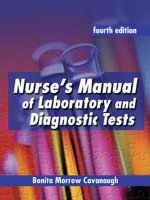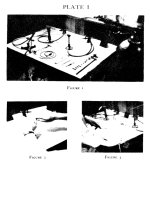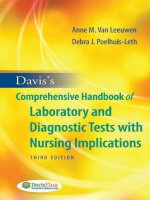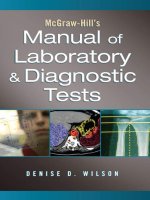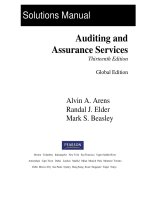McGraw hills manual of laboratory and diagnostic tests 2008
Bạn đang xem bản rút gọn của tài liệu. Xem và tải ngay bản đầy đủ của tài liệu tại đây (10.71 MB, 681 trang )
McGraw-Hill’s
Manual of
Laboratory
& Diagnostic
Tests
Notice
Medicine is an ever-changing science. As new research and clinical experience broaden our knowledge, changes in treatment and drug therapy are
required. The authors and the publisher of this work have checked with
sources believed to be reliable in their efforts to provide information that
is complete and generally in accord with the standards accepted at the
time of publication. However, in view of the possibility of human error or
changes in medical sciences, neither the authors nor the publisher nor
any other party who has been involved in the preparation or publication of
this work warrants that the information contained herein is in every
respect accurate or complete, and they disclaim all responsibility for any
errors or omissions or for the results obtained from use of the information
contained in this work. Readers are encouraged to confirm the information contained herein with other sources. For example and in particular,
readers are advised to check the product information sheet included in
the package of each drug they plan to administer to be certain that the
information contained in this work is accurate and that changes have not
been made in the recommended dose or in the contraindications for
administration. This recommendation is of particular importance in connection with new or infrequently used drugs.
McGraw-Hill’s
Manual of
Laboratory
& Diagnostic
Tests
D E N I S E D . W I L S O N , P H D , A P N , F N P, A N P
Associate Professor
Mennonite College of Nursing
Illinois State University
Normal, Illinois
Family Nurse Practitioner/Adult Nurse Practitioner
Medical Hills Internists & Pediatrics
Bloomington, Illinois
New York Chicago San Francisco Lisbon London Madrid Mexico City
New Delhi San Juan Seoul Singapore Sydney Toronto
Copyright © 2008 by The McGraw-Hill Companies, Inc. All rights reserved. Manufactured in the United States
of America. Except as permitted under the United States Copyright Act of 1976, no part of this publication may
be reproduced or distributed in any form or by any means, or stored in a database or retrieval system, without
the prior written permission of the publisher.
0-07-159405-1
The material in this eBook also appears in the print version of this title: 0-07-148152-4.
All trademarks are trademarks of their respective owners. Rather than put a trademark symbol after every
occurrence of a trademarked name, we use names in an editorial fashion only, and to the benefit of the
trademark owner, with no intention of infringement of the trademark. Where such designations appear in this
book, they have been printed with initial caps.
McGraw-Hill eBooks are available at special quantity discounts to use as premiums and sales promotions, or for
use in corporate training programs. For more information, please contact George Hoare, Special Sales, at
or (212) 904-4069.
TERMS OF USE
This is a copyrighted work and The McGraw-Hill Companies, Inc. (“McGraw-Hill”) and its licensors reserve all
rights in and to the work. Use of this work is subject to these terms. Except as permitted under the Copyright
Act of 1976 and the right to store and retrieve one copy of the work, you may not decompile, disassemble,
reverse engineer, reproduce, modify, create derivative works based upon, transmit, distribute, disseminate, sell,
publish or sublicense the work or any part of it without McGraw-Hill’s prior consent. You may use the work for
your own noncommercial and personal use; any other use of the work is strictly prohibited. Your right to use the
work may be terminated if you fail to comply with these terms.
THE WORK IS PROVIDED “AS IS.” McGRAW-HILL AND ITS LICENSORS MAKE NO GUARANTEES
OR WARRANTIES AS TO THE ACCURACY, ADEQUACY OR COMPLETENESS OF OR RESULTS TO
BE OBTAINED FROM USING THE WORK, INCLUDING ANY INFORMATION THAT CAN BE
ACCESSED THROUGH THE WORK VIA HYPERLINK OR OTHERWISE, AND EXPRESSLY DISCLAIM
ANY WARRANTY, EXPRESS OR IMPLIED, INCLUDING BUT NOT LIMITED TO IMPLIED
WARRANTIES OF MERCHANTABILITY OR FITNESS FOR A PARTICULAR PURPOSE. McGraw-Hill
and its licensors do not warrant or guarantee that the functions contained in the work will meet your requirements or that its operation will be uninterrupted or error free. Neither McGraw-Hill nor its licensors shall be
liable to you or anyone else for any inaccuracy, error or omission, regardless of cause, in the work or for any
damages resulting therefrom. McGraw-Hill has no responsibility for the content of any information accessed
through the work. Under no circumstances shall McGraw-Hill and/or its licensors be liable for any indirect,
incidental, special, punitive, consequential or similar damages that result from the use of or inability to use the
work, even if any of them has been advised of the possibility of such damages. This limitation of liability shall
apply to any claim or cause whatsoever whether such claim or cause arises in contract, tort or otherwise.
DOI: 10.1036/0071481524
I dedicate this book to…
…those who care for others…may you always remember that it is an honor and a
privilege to be allowed to share in others’ lives
…those for whom we care…may you always be treated with respect and kindness
This page intentionally left blank
For more information about this title, click here
CONTENTS
Preface | ix
Acknowledgments | xi
Introduction | xiii
Alphabetical Listing of 359 Laboratory and Diagnostic Tests | 3
Appendix A: Typical Groupings of Blood/Urine Tests | 619
Appendix B: The Endocrine System: Signals & Feedback | 624
Appendix C: Safety of the Patient | 627
Appendix D: Safety of the Health-Care Provider | 631
Appendix E: Evidence-Based Practice | 633
Bibliography | 638
Index | 647
This page intentionally left blank
P R E FA C E
McGraw-Hill’s Manual of Laboratory & Diagnostic Tests was developed to provide
up-to-date information on the most commonly used laboratory and diagnostic tests. To
provide this information quickly, the tests are provided in alphabetical order using an
easy-to-follow format. New tests such as BRCA, FISH, NT-proBNP, and video capsule
endoscopy are included. A unique feature of the text is the provision, when available, of
selected aspects of evidence-based practice guidelines related to the particular test.
Familiarity with these guidelines is essential in caring for the individual with such conditions as diabetes, hypertension, and hyperlipidemia, as well as in determining appropriate
screening tests.
Following the alphabetical listing of the laboratory and diagnostic tests, five appendices have been included.
• Appendix A includes a list of common tests for particular conditions or those typically
grouped for processing.
• Appendix B has been included to explain how the endocrine system works and how this
foundational knowledge can be applied to understand various laboratory tests related to
endocrine disorders.
• Appendix C provides information on patient safety issues. The 2007 JCAHO National
Patient Safety Goals related to laboratory and diagnostic testing are discussed. Additional
discussion focuses on communication of test results in light of HIPAA regulations.
• Appendix D discusses safety of the health-care provider related to universal precautions/
bloodborne pathogens.
• Appendix E discusses what evidence-based practice (EBP) is, its historical foundations,
and steps of the EBP process. It also provides internet resources for clinical practice
guidelines and evidence to be used in clinical decision-making.
The appendices are followed by a bibliography of sources used for this text, including
the evidence-based practice guidelines, and a comprehensive index listing of all test names
and abbreviations used in the text.
It is my hope that you, the reader, find this a helpful resource as you strive to provide
quality patient care.
Denise D. Wilson
Copyright © 2008 by The McGraw-Hill Companies, Inc. Click here for terms of use.
This page intentionally left blank
ACKNOWLEDGMENTS
I would like to acknowledge and thank those individuals who have, in some way, played a
part in the completion of this text. Thank you to:
Quincy McDonald, Senior Acquisitions Editor for McGraw-Hill, for enthusiastically supporting this project and keeping me on track (most of the time!).
Christie Naglieri, Project Development Editor, for her diligence in developing each aspect
of the text.
Sandi Burke, PhD, RN, for her thoughtful review of the appendix on evidence-based
practice.
My colleagues at Mennonite College of Nursing at Illinois State University and
Medical Hills Internists & Pediatrics, for their encouragement, sharing of knowledge,
and friendship throughout the years.
My graduate family nurse practitioner students, for making me glad that I am a teacher
of nursing and appreciating my need and desire to practice.
My patients, for making me proud that I am a nurse practitioner and being so appreciative of the care I provide.
My family and friends, for always being there to offer support.
My mother, Ida Williams, for being a loving Mom and such a supporter of my work and
dreams throughout my life.
My husband, Gary Wilson, for believing in me, for doing all the things around home that
I did not have time for while working on this project, and for showing his love in so many
ways.
Copyright © 2008 by The McGraw-Hill Companies, Inc. Click here for terms of use.
This page intentionally left blank
INTRODUCTION
The laboratory and diagnostic tests of McGraw-Hill’s Manual of Laboratory & Diagnostic
Tests are presented in a consistent format designed to focus on what is important for the
health-care provider of today. The following format is used for each test.
NAME OF THE TEST
The primary test name is given, followed by other commonly used names and abbreviations.
TEST DESCRIPTION
The description provides a foundation for understanding the test: its purpose, how it assists
in the diagnosis of various conditions, relevant physiology, and the meaning of results in
conjunction with other tests which might be performed.
THE EVIDENCE FOR PRACTICE
When available, relevant evidence-based practice guidelines have been included to assist
the primary care provider in clinical decision-making. Discussion about evidence-based
practice can be found in Appendix E. Reference sources for these guidelines are noted here
and/or in the Bibliography.
NORMAL VALUES
The normal values listed are intended to serve as general guidelines, or reference values.
They are not meant to replace test norms provided by each laboratory. When available, values are given in both conventional and SI units. Conventional units, such as milligram and
liter, as those which have been used historically in health-care in the United States. In an
attempt to standardize the measurements world-wide, a system of international (SI) units
was developed. SI units have not yet become the standard in all parts of the world, thus both
conventional units and SI units are included for all tests, when available. Conversion factors
for various laboratory components can be found at the website for the Journal of the
American Medical Association (JAMA) at />issue1/images/data/103/DC6/JAMA_auinst_si.dtl
POSSIBLE MEANINGS OF ABNORMAL VALUES
This section provides a compilation of conditions which may account for an abnormal test
result. The lists are presented alphabetically to assist the reader in quickly locating the
desired information.
CONTRIBUTING FACTORS TO ABNORMAL VALUES
This section provides information regarding patient conditions, equipment or procedural
peculiarities, foods, and drugs which may affect test results. Drugs are listed either as individual generic names, or, when an entire group of drugs is applicable, as a broad classification.
Copyright © 2008 by The McGraw-Hill Companies, Inc. Click here for terms of use.
xiv INTRODUCTION
INTERVENTIONS/IMPLICATIONS
This section includes the patient education and preparation required during the pretest
period, the steps of the test/procedure, and the posttest care of the patient. Most procedures
involve potential contact with the patient’s body fluids. The institution’s infection control
policy regarding collection and handling of specimens should be reviewed and carefully
followed. This includes compliance with the universal precautions developed by the
Centers for Disease Control and Prevention (CDC) discussed in Appendix D.
CLINICAL ALERTS
This section lists in bold print the possible complications of a procedure. It also includes suggested patient education, follow-up testing needed, and applicable clinical tips from practice.
CONTRAINDICATIONS
This section lists the primary types of patients upon whom a particular test should not be
performed. In addition, the health-care provider must always assess the individual patient
to determine the presence of other factors which may cause the test to be contraindicated
for that particular patient.
Laboratory
and
Diagnostic
Tests
Copyright © 2008 by The McGraw-Hill Companies, Inc. Click here for terms of use.
This page intentionally left blank
ABDOMINAL AORTA SONOGRAM 3
Abdominal Aorta Sonogram
(Ultrasound of the Abdominal Aorta)
Test Description
Ultrasonography is a noninvasive method of diagnostic testing in which ultrasound
waves are sent into the body with a small transducer pressed against the skin. The
transducer then receives any returning sound waves, which are deflected back as
they bounce off various structures. The transducer converts the returning sound
waves into electric signals that are then transformed by a computer into a visual display on a monitor.
In this particular type of ultrasonography, the transducer is passed over the area
from the xiphoid process to the umbilicus. The purpose is to detect and measure a
suspected abdominal aortic aneurysm (AAA). It can also be used to monitor a known
AAA for increase in size. The lumen of the abdominal aorta is normally less than
4 cm in diameter. It is considered to be aneurysmal if it is greater than 4 cm and
at high risk of rupture if it is greater than 7 cm. This test can also be used as a follow-up evaluation after surgery for repair of an aneurysm.
THE EVIDENCE FOR PRACTICE
The U.S. Preventive Services Task Force recommends one-time screening for AAA by ultrasonography in men aged 65 to 75 who have ever smoked. The Task Force makes no recommendation for or against screening for AAA in men aged 65 to 75 who have never smoked,
and recommends against routine screening for AAA in women. (See: www.ahrq.gov/clinic/
uspstf/uspsaneu.htm)
Normal Values
Negative for presence of aneurysm
Abdominal aorta lumen diameter <4 cm
Possible Meanings of Abnormal Values
Abdominal aortic aneurysm
Contributing Factors to Abnormal Values
•
•
The transducer must be in good contact with the skin as it is being moved.
Clear imaging can be hampered by the presence of retained gas or barium in the
intestine, obesity, and patient movement.
Interventions/Implications
Pretest
•
•
Explain to the patient the purpose of the test. Provide any written teaching materials
available on the subject. Note that there is no discomfort involved with this test.
Fasting for 8 hours is required prior to the exam.
Procedure
•
•
The patient is assisted to a supine position on the ultrasonography table.
A coupling agent, such as a water-based gel, is applied to the area to be evaluated.
A
4 LABORATORY AND DIAGNOSTIC TESTS
A
•
•
A transducer is placed on the skin and moved as needed to provide good visualization of
the structures.
The sound waves are transformed into a visual display on the monitor. Printed copies of
this display are made.
Posttest
•
•
Cleanse the patient’s skin of remaining coupling agent.
Report abnormal findings to the primary care provider.
R Clinical Alerts
•
This test should be scheduled for completion prior to any studies requiring barium. If such studies have already occurred, 24 hours must pass prior to performing the ultrasound to allow passage of the barium beyond the area to be viewed.
Abdominal Sonogram
(Abdominal Ultrasound)
Test Description
Ultrasonography is a noninvasive method of diagnostic testing in which ultrasound
waves are sent into the body with a small transducer pressed against the skin. The
transducer then receives any returning sound waves, which are deflected back as
they bounce off various structures. The transducer converts the returning sound
waves into electric signals that are then transformed by a computer into a visual display on a monitor.
In this particular type of ultrasonography, the areas evaluated include those
studied in the liver and pancreatobiliary system sonogram (gallbladder, biliary system, liver, and pancreas) along with the spleen, kidneys, and aorta.
Normal Values
Normal appearance of gallbladder, biliary system, liver, pancreas, spleen, kidneys, and
aorta
Possible Meanings of Abnormal Values
•
•
•
•
•
•
•
•
Aortic aneurysm
Ascites
Cholecystitis
Cholelithiasis
Cirrhosis of the liver
Dilation of the bile ducts
Gallbladder carcinoma
Gallbladder polyps
ABDOMINAL SONOGRAM 5
•
•
•
•
•
•
•
•
•
•
•
•
•
•
•
•
Hematoma
Hepatic abscess
Hepatic tumor
Hepatocellular disease
Hydronephrosis
Liver cyst
Liver metastases
Pancreatic carcinoma
Pancreatitis
Pheochromocytoma
Pseudocyst of the pancreas
Renal calculi
Renal carcinoma
Renal cysts
Ruptured spleen
Splenomegaly
Contributing Factors to Abnormal Values
•
•
The transducer must be in good contact with the skin as it is being moved. A waterbased gel is used to ensure good contact with the skin.
Test results are hindered by the presence of bowel gas, retained barium, or
obesity.
Interventions/Implications
Pretest
•
•
Explain to the patient the purpose of the test. Provide any written teaching materials
available on the subject. Note that there is no discomfort involved with this test.
The patient is to eat a fat-free meal in the evening and then fast for 8 to 12 hours before
the test. This promotes accumulation of bile in the gallbladder, resulting in better visualization during ultrasonography.
Procedure
•
•
•
•
The patient is assisted to a supine position on the ultrasonography table.
A coupling agent, such as a water-based gel, is applied to the area to be evaluated.
A transducer is placed on the skin and moved as needed to provide good visualization of
the structures.
The sound waves are transformed into a visual display on the monitor. Printed copies of
this display are made.
Posttest
•
•
Cleanse the patient’s skin of any lubricant.
Report abnormal findings to the primary care provider.
R Clinical Alerts
•
For patients with clinical suggestion of gallbladder disease who have a negative
abdominal ultrasound, a hepatobiliary iminodiacetic acid (HIDA) scan of the gallbladder may be needed.
A
6 LABORATORY AND DIAGNOSTIC TESTS
A
Abdominal X-ray
(Kidney, Ureter, and Bladder Radiography,
KUB, Flat Plate X-ray of the Abdomen, Scout Film)
Test Description
The abdominal x-ray, often referred to as a flat plate of the abdomen or KUB, provides an overall view of the lower abdomen that shows the position of the kidneys,
ureters, and bladder. The ureters are not normally visible on the KUB unless abnormal, as when calculi are present. The test is a simple x-ray film with the patient in
a supine position. It requires no physical preparation of the patient. Renal enlargement, renal displacement, congenital anomalies, and renal or ureteral calculi are
just a few of the abnormalities that may be seen as a result of this test. In addition
to abnormalities of the urinary tract, the KUB may be used to assess for the presence of ascites and for gas within the intestines, which may occur with intestinal
obstruction.
THE EVIDENCE FOR PRACTICE
The plain film of the abdomen may be sufficient to diagnose ureterolithiasis in patients with
known stone disease and previous KUBs. The sensitivity of the KUB for ureterolithiasis in
other patients is poor; such patients might benefit more from having a noncontrast CT.
Normal Values
Normal size, shape, and location of kidneys. Ureters not seen. Bladder shown as
shadow. Normal intestinal gas pattern.
Possible Meanings of Abnormal Values
•
•
•
•
•
•
•
•
•
•
•
Accumulation of gas in intestine
Ascites
Calculi
Congenital abnormalities
Cysts
Hydronephrosis
Intestinal obstruction
Paralytic ileus
Renal trauma
Tumor
Vascular calcifications
Contributing Factors to Abnormal Values
•
•
Any movement by the patient may alter quality of films taken.
Retained barium, gas, or stool in the intestines may alter the test results.
Interventions/Implications
Pretest
•
•
Explain to the patient the purpose of the test. Provide any written teaching materials
available on the subject. Note that the test involves no discomfort.
No fasting is required before the test.
ACETYLCHOLINE RECEPTOR ANTIBODIES 7
•
The test should be completed before the patient has any diagnostic tests involving
barium.
Procedure
•
•
•
The patient is assisted to a supine position on the radiography table.
The patient’s arms are extended overhead.
Films are taken of the patient’s abdomen.
Posttest
•
•
Report abnormal findings to the primary care provider.
Schedule any additional testing for differential diagnosis as ordered.
R Clinical Alerts
•
The test should be scheduled prior to or at least 24 hours after any barium studies are conducted.
Acetylcholine Receptor Antibodies
(AChR, Anti-ACh Antibodies)
Test Description
Acetylcholine (ACh) and the catecholamines (epinephrine and norepinephrine) are
the main neurotransmitters of the autonomic nervous system. In normal contraction
of the muscles, ACh is released from the terminal end of the nerve into the neuromuscular junction. ACh then binds with receptor sites on the muscle membrane,
resulting in the opening of sodium channels. This allows sodium ions to enter and
depolarize the cell. This begins an action potential that passes along the entire
muscle fiber, resulting in muscle contraction.
Myasthenia gravis (MG) is an autoimmune disease that affects neuromuscular
transmission. In this disease, antibodies form that interfere with the binding of ACh
to the receptor sites on the muscle membrane. This prevents muscle contraction
from occurring. These antibodies are present in more than 85% of the patients with
MG. Thus, this test is used for diagnosis of MG and for monitoring the patient’s
response to immunosuppressive therapy for the disease.
Normal Values
Negative or ≤0.03 nmol/L
Possible Meanings of Abnormal Values
Increased
Myasthenia gravis
Contributing Factors to Abnormal Values
•
•
False-positive results may occur in patients with amyotrophic lateral sclerosis (ALS).
Drugs that may decrease ACh receptor antibody titers: immunosuppressive drugs.
A
8 LABORATORY AND DIAGNOSTIC TESTS
A
Interventions/Implications
Pretest
•
•
Explain to the patient the purpose of the test and the need for a blood sample to be drawn.
No fasting is required before the test.
Procedure
•
•
A 7-mL blood sample is drawn in a red-top tube.
Gloves are worn throughout the procedure.
Posttest
•
•
•
Apply pressure at venipuncture site. Apply dressing, periodically assessing for continued
bleeding.
Label the specimen and transport it to the laboratory.
Report abnormal findings to the primary care provider.
R Clinical Alerts
•
•
Three types of acetylcholine receptor antibodies are available for testing. The
most common is the ACh receptor binding antibody. If this test is negative, testing for the blocking antibody and the modulating antibody should be done.
The ACh receptor blocking antibody is especially useful in monitoring response
to therapy.
Acid-Fast Bacilli
(AFB)
Test Description
The acid-fast method is a special staining technique that is particularly useful when
identifying mycobacteria in sputum specimens, which often contain a variety of
organisms. Examples of mycobacteria are those causing leprosy, tuberculosis, and
respiratory infection in patients with acquired immunodeficiency syndrome (AIDS).
Mycobacteria retain stain coloring even after treatment with a decolorizing acidalcohol solution. Once bacilli are determined to be acid-fast, a culture is done to
differentiate the type of mycobacteria, along with sensitivity testing to determine
appropriate pharmacologic treatment.
THE EVIDENCE FOR PRACTICE
Any patient with a cough lasting ≥2 to 3 weeks, with at least one additional symptom including fever, night sweats, weight loss, or hemoptysis, should have a chest radiograph. If suggestive of tuberculosis, three consecutive morning sputum specimens for AFB should be
collected.
Normal Values
Negative for bacilli
ACID-FAST BACILLI 9
Possible Meanings of Abnormal Values
Positive
AIDS
Leprosy
Tuberculosis
Contributing Factors to Abnormal Values
•
Collection of saliva, rather than sputum, will provide inaccurate test results.
Interventions/Implications
Pretest
•
•
•
•
•
The sputum should be collected before antimicrobial therapy is begun.
Explain to the patient the purpose of the test and the need for a sputum specimen.
Explain the procedure to the patient:
• An early morning specimen is best, because sputum is most concentrated at that time.
• The patient should brush the teeth and rinse the mouth with water before collecting
the sputum to reduce contamination of the sample.
• The sputum must be from the bronchial tree. The patient must understand this is
different from saliva in the mouth.
• The sample is collected in a sterile sputum container.
If tuberculosis is suspected, three consecutive morning specimens may be ordered. This
increases the chance of isolating the microbes.
If the sputum is very thick, it can be thinned by inhaling nebulized saline or water or by
increasing fluid intake the evening before sample collection. Postural drainage and chest
physiotherapy may also prove helpful.
Procedure
•
•
•
•
The patient should take several deep breaths and then cough deeply to obtain the sputum.
At least one teaspoon of sputum is needed.
If specimen collection via coughing is ineffective, endotracheal suctioning and fiberoptic bronchoscopy are other options.
After collection of the sputum, the sample is sent to the laboratory for a Gram stain. This
is used to differentiate between true sputum and saliva, which contains many epithelial
cells. Decolorizing solution is used to determine acid-fastness of the bacilli.
The sputum is then placed on the appropriate culture medium and allowed to incubate.
Final reports for tuberculosis (AFB culture) may take 1 to 6 weeks.
Posttest
•
•
•
Label the specimen container and transport it to the laboratory as soon as possible. Note
any current antimicrobial therapy on the label.
Gloves should be worn when handling the specimen.
Report positive results to the primary care provider.
R Clinical Alerts
•
A positive AFB smears indicates a likely mycobacterial infection. The AFB culture is then used to identify the specific mycobacteria.
A
10 LABORATORY AND DIAGNOSTIC TESTS
A
•
If the AFB smear/culture is positive after several weeks of drug treatment, this
indicates ineffective treatment and that the patient is still infectious. A change
of treatment regimen would be warranted.
Acid Phosphatase
(Prostatic Acid Phosphatase [PAP])
Test Description
Acid phosphatase, also known as prostatic acid phosphatase (PAP), is an enzyme
found primarily in the prostate gland, with high concentrations found in the seminal fluid. It is found in smaller concentrations in the kidneys, liver, spleen, bone
marrow, erythrocytes, and platelets. Acid phosphatase is used to diagnose advanced
metastatic cancer of the prostate and to monitor the patient’s response to therapy
for prostate cancer.
In the past, this test has been considered a tumor marker for prostatic cancer.
However, with the advent of the prostate-specific antigen (PSA) test, monitoring of
the acid phosphatase is decreasing in popularity. An additional use of acid phosphatase testing is testing for its presence in vaginal secretions during the investigation of cases of alleged rape.
THE EVIDENCE FOR PRACTICE
According to guidelines of the American Academy of Pediatrics for evaluation of sexual
abuse in children ( a high
acid phosphatase level in a child is suggested as one criterion for reporting suspected sexual abuse.
Normal Values
2.2–10.5 U/L (37–175 nkat/L SI units)
Possible Meanings of Abnormal Values
Increased
Acute renal impairment
Bone metastases
Breast cancer
Cirrhosis
Eclampsia
Gaucher’s disease
Hemolytic anemia
Hepatitis
Hyperparathyroidism
Liver tumor
Multiple myeloma
Obstructive jaundice
Paget’s disease
